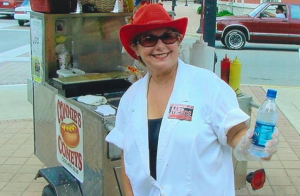Hey there! Make sure you read this entire article. This is huge news. If you are thinking about starting a hot dog cart business, now is the time. Don’t wait too long or soon you’ll see somebody making big money with a hot dog cart on the spot you had in mind. Click here to learn everything you need to know.
WALL STREET JOURNAL ONLINE – BANDERA, TEXAS — In hard times, some small-town Americans are turning to a new livelihood with relish.
Among them are Andrea and Ben Guajardo. They began selling hot dogs from a pushcart on Main Street in November.
Ms. Guajardo is a grant administrator for a health-care system. Her husband, Ben, is a pipeline operator. Theirs is the first hot-dog stand in Bandera, pop. 957, that anybody here can remember.
“It’s a backup plan,” says Ms. Guajardo, a mother of four. “No one knows what’s going to happen with the economy, and I don’t want to have to scrounge for a minimum-wage job.”
Andrea and Ben Guajardo both work full-time, but began selling wieners with help from their four kids in November.
Facing pay cuts and weakened job security, more Americans are turning to this century-old, big-city trade in outposts like Bandera, where cowboys on horseback share the road with motorcyclists. Many of these vendors are working professionals with day jobs, ranging from real-estate agents to train operators.
Sales of carts, which start at about $2,000 new, have heated up in the past year. “Every model is…taking off,” says Joel Goetz, owner of American Dream Hot Dog Carts Inc. in St. Petersburg, Fla. Since January, he has sold about 25 carts a week, 15 more than usual.
Editor’s note: You can build your own hot dog cart (shown at left) for $500 – $800 using hardware store parts. No welding, riveting, or special skills required. It’s so easy that anyone can do it! For more info go to BuildAHotDogCart.com.
“Business is really off the charts,” says Dan Jackson, a division manager at Nation’s Leasing Services in Newbury Park, Calif. Leases for hot-dog carts account for about three-quarters of sales, and revenue is triple what it was this time a year ago, he says.
Hot dog vendors are a familiar sight in big cities around the country. For one Texas family, their weekend business is bringing in extra cash amid a slumping economy.
Today’s cart buyers are generally older and have more white-collar work experience than was traditionally the case, says Will Hodgskiss, president and “top dog” at Willy Dog Ltd., a New York cart manufacturer. “People are either buying these carts in anticipation of a layoff or to supplement their incomes,” he says. Willy Dog’s sales are up 30% from March 2007.
Street Food of Choice
Hot dogs are the street food of choice for vendors because frankfurters are sold precooked and therefore tend to undergo less scrutiny from state and city health departments. They’re also popular. Between Memorial Day and Labor Day, Americans typically consume seven billion hot dogs, according to the American Meat Institute’s National Hot Dog & Sausage Council.
“It’s a very recession-proof business,” says Kurt Horlacher, a former sheet-metal worker who co-owns four hot-dog stands in Sarasota, Fla., with his wife, Renee, a former registered nurse.
The two say their sales have increased 20% annually since they started two years ago, and they plan to open three more stands later this year. Their eight employees, who are paid $8 an hour, include laid-off professionals and part-time workers looking to augment their earnings. “I get three to five people applying for jobs each week,” says Mr. Horlacher.
A 25% increase in year-over-year cart sales has prompted one manufacturer, All American Hot Dog Carts Inc., to offer classes in how to succeed in wiener work. Later this month, Hot Dog University will cover everything from the right way to squirt mustard (in a swirling motion with a quick flick of the wrist) to how to heat up buns (steam them over the dogs for two minutes before serving).
[hot dog]
Then there’s the art of the sell. “You got to schmooze people,” says Louie Di Raimondo, the Miami company’s founder and self-appointed hot-dog king.
A skilled cart dealer in a pedestrian-heavy area can net up to $400 a day, say many vendors and cart-company officials. Newer dealers and those in less-ideal locations make one-third to half that amount. Weekend and event-only vendors, like the Guajardos, say that when the weather is good, they too can turn a hefty profit.
The Guajardos manage their two-wheeled stainless-steel hot-dog cart just on weekends, from about 11 a.m. to 2 p.m., in this Texas Hill Country downtown dotted with hitching posts, heavy-duty pickup trucks and cowboys leading cattle. They set up again on Saturday nights outside local honky-tonks like the Longhorn Saloon. They average $1,150 in take-home earnings each weekend selling roughly 400 dogs, plus drinks, chips and pickles. The couple’s four children often help out during the day.
“I tell them, ‘Your mom’s going to pay for your college education with hot dogs,” says Ms. Guajardo, while directing her oldest son, 13-year-old Ben, to put some more cans of soda and bottled water on ice. The business is named after another son, 6-year-old “Big Lou.”
Before they started, “you could find a flying frog easier than a hot-dog stand,” said 75-year-old William Ellis recently as he waited for a Chicago-style frankfurter, including neon green relish and sport peppers atop a poppy-seed bun.
For others, hot-dogging is a stopgap. Real-estate investor Marty Katzenberger turned to it after the housing market tanked and he couldn’t sell any of his properties. “I found that I’m a little clumsy with my hot dogs,” says the 72-year-old, who withdrew $4,200 from his retirement savings to get started at a Sarasota, Fla., beach resort. Mr. Katzenberger, who generates an average of $150 in profits a day and works five days a week, says he’s considering moving to a new location to boost his earnings further.
The work — which requires hours of standing — can be quite an adjustment for people accustomed to sitting behind desks at 9-to-5 jobs. There’s also a lot of preparation and cleaning involved.
Then there’s the growing competition. Many small cities and towns have never had to worry much about enforcing laws that limit the number of pushcarts — until now.
Connie Means, a former college math professor who owns four wiener stands in Gadsden, Ala., recently encountered her first competition since starting her business in 2003. It came from a husband and wife who had previously sought her advice on becoming hot-dog vendors. “I tried to help them,” says Ms. Means, who makes about $42,000 annually working six days a week. “I didn’t realize they were going to set up two or three blocks from me.”
Growing Competition
Gadsden officials say there are more competitors on the way. The municipality of about 37,000 is now considering changes to a vending ordinance that would require new carts to be farther apart from one another. “They all want to be in a four-block radius,” says Shane Ellison, a city planner.
 After Jerry and Sandra Mottola ordered a $3,000 hot-dog cart online recently, they discovered that there were only two available locations zoned for the purpose in their hometown of Haverhill, Mass. A local hardware store rejected the couple’s request to set up on its property. Ultimately, they scored an open spot near a courthouse, library and shopping plaza.
After Jerry and Sandra Mottola ordered a $3,000 hot-dog cart online recently, they discovered that there were only two available locations zoned for the purpose in their hometown of Haverhill, Mass. A local hardware store rejected the couple’s request to set up on its property. Ultimately, they scored an open spot near a courthouse, library and shopping plaza.
Mr. Mottola hopes his new business, Family Hot Dog, will supplement his sagging income as a home contractor. “I’m creating my own stimulus plan,” he says. “I’m not waiting for the president.”
Get started. Find out how at www.HotDogBiz101.com.
original article by Sarah Needleman at Wall Street Journal Online



My cart passed the health dept. last week, and this afternoon, the Downtown Development Assn is dropping by to check it out too. They tell me when they leave, I should have the permit to operate in my hot little hand.
My site, for which I pay the city $125 a year, is in a little pocket park right on the main street in this college town of over 100,000. Downtown in Lafayette is very alive, and I will be pushing dogs weekdays 11 – 2, and weekend nights 6 – midnight (mandatory closing time).
I am very encouraged when I read about the successes of HDC vendors in much smaller towns. This time tomorrow, we should be picking up my cart from my “commisary”. Their door won’t accomodate my cart, and today, when I am done with the bureaucrats, I am helping them knock out a wall to install a door 6 feet wide. Couldn’t have come up with a better “commisary”. They don’t even want me to pay them. I would like to nominate them for sainthood now!
Only one other person has a HDC permit here, and she comes out just for the big special events.
My crew consists of my college student sons. Saturday, we had a “test run”, using friends and neighbors as “guinea pigs” There were no casualties, and everyone liked the dogs, po boys, and nachos. I think we are ready to boogie!!
Russ,
Congratulations, your timing is perfect. This is the best time in decades to start a hot dog cart business and you got in on the beginning of the wave. You’re really going to do well as it builds from here on out!
-Steve
Steve,
I have been meaning to mention that I am impressed by your including Dale Carnegie’s book in your package. For over 30 years, I have been leading my life by the Golden Rule and Carnegie’s books/philosophy. Those two and a good grounding in Transactional Analysis, and i am good to go. Oh, and a quality hot dog…..
The “moon and the stars and planets are all aligned” and must be “in my house”! There have been several favorable stories in the press recently, and the timing couldn’t be better! I’m almost finished with a season of school bus driving, and my cart is just about ready to roll off my “one-man assembly line” and get “up and running”!
In honor of Steve and the inspiration he’s given me, I’m calling my cart a “Schaible Deluxe”! Steve encourages builders to use whatever skills and tools they have, and I have done just that–with the result of some unique modifications that I think Steve and some other builders might like and find interesting! It wouldn’t have been possible, however, without Steve’s basic plan and guidance! (Thanks for your check in the mail, Steve! JUST KIDDING FOLKS!!)
Standby! I hope to upload some pictures in a couple of weeks!
RICK BURDICK
“Mr. Goode O’Day’s” Hot Dogs
Omaha
DONT CHANGE THE WIENER!!!
I have been in the same situation before. It is not as easy an answer as you think it is, its something that you will have to write out for yourself over time.